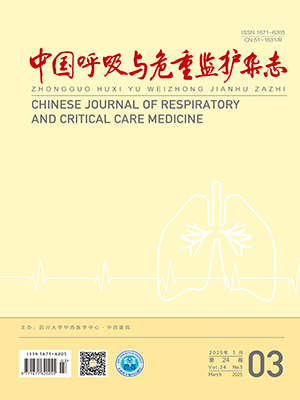Objective To investigate the causes of chronic cough in Chongqing City and assess the efficacy of specific therapy. Methods A total of 233 consecutively non-selected referred patients ( 136 females) whose cough duration more than eight weeks were studied. Their age[ median ( range) ] was 44. 5( 15-78) yrs and cough duration was 2. 6 ( 0. 2-30) yrs. They were diagnosed using a diagnostic protocol based on the Guideline on Diagnosis and Treatment of Chronic Cough established by China Medical Association and American College of Chest Physicians. The etiological diagnosis was made according to clinical manifestations, lab examinations, and response to specific therapy. The effects was assessed four weeks after the drug withdraw. Results The cause of chronic cough was confirmed in 216 patients ( 92. 7% ) . Seventeen patients( 7. 3% ) had not been definitely diagnosed. Cough due to a single cause was found in 163 patients ( 75. 45% ) , and due to multiple causes in 53 patients ( 24. 53% ) . The causes included upper airway cough syndrome ( UACS) in 127 patients( 44. 4% ) , cough variant asthma ( CVA) in 73 patients( 25. 5% ) , gastro-esophageal reflux cough ( GERC) in 26 patients( 9. 1%) , postinfectious cough and angiotensin converting enzyme ( ACE) inhibitor-induced cough in 6 patients( 2. 1% ) , atopic cough in 5 patients( 1. 7% ) , chronic bronchitis in 3 patients ( 1. 0% ) , respectively. After specific therapy based on diagnosis, cough cured in 59 patients ( 25. 3% ) , and alleviated in 114 patients ( 49. 3% ) , no response in 40 patients( 17. 1% ) . Conclusion The causes of chronic cough in different areas maybe variant. UACS, CVA and GREC are the main causes of chronic cough in Chongqing City. Specific therapy is effective in majority of patients with chronic cough.
Citation:
CAO Guoqiang,CHENG Xiaoming,DAI Xiaotian,XIONGWei,CHENHong,SUYi,WANG Daoxin,JIANG Youfan,WANG Changzheng. A Multi-Center Study on Clinical and Etiological Diagnosis of Chronic Cough in Chongqing City. Chinese Journal of Respiratory and Critical Care Medicine, 2009, 09(6): 565-568. doi:
Copy
Copyright © the editorial department of Chinese Journal of Respiratory and Critical Care Medicine of West China Medical Publisher. All rights reserved
| 1. |
Pratter MR. Overview of Common Causes of Chronic Cough: ACCP Evidence-Based Clinical Practice Guidelines. Chest, 2006 , 129 :59S-62S.
|
| 2. |
赖克方, 陈如冲, 刘春丽, 等. 不明原因慢性咳嗽的病因分布及诊断程序的建立. 中华结核和呼吸杂志, 2006, 29: 96-99.
|
| 3. |
王志虹, 林江涛, 李勇, 等. 慢性咳嗽的病因诊断及治疗效果. 中国医学科学院学报, 2007, 29: 665-668.
|
| 4. |
马洪明, 朱礼星, 赖克方, 等. 不明原因慢性咳嗽的诊断探讨. 中华结核和呼吸杂志, 2003, 26: 675-678.
|
| 5. |
中华医学会呼吸病学分会哮喘学组. 咳嗽的诊断与治疗指南( 草案) . 中华结核和呼吸杂志, 2005, 28: 738-744.
|
| 6. |
Irwin RS, Baumann MH, Bolser DC. et al. Diagnosis and Management of Cough Executive Summary: ACCP Evidence-Based Clinical Practice Guidelines. Chest, 2006, 129: 1S-23S.
|
| 7. |
Pratter MR. Chronic Upper Airway Cough Syndrome Secondary to Rhinosinus Diseases ( Previously Referred to as Postnasal Drip Syndrome) : ACCP Evidence-Based Clinical Practice Guidelines.Chest, 2006, 129: 63S-71S.
|
| 8. |
Morice AH. Chronic cough: Epidemiology. Chron Respir Dis, 2008 ,5: 43-47.
|
| 9. |
Irwin RS. Introduction to the diagnosis and management of cough:ACCP evidence-base clinical practice guidelines. Chest, 2006, 129 :25S-27S.
|
| 10. |
Pratter MR. Overview of Common Causes of Chronic Cough: ACCP evidence-based clinical practice guidelines. Chest, 2006 , 129: 59S-62S.
|
| 11. |
Kastelik JA, Aziz I, Ojoo JC, et al. Investigation and management of chronic cough using a probability-based algorithm. Eur Respir J,2005, 25: 235-243.
|
| 12. |
何权瀛. 对于慢性咳嗽诊断治疗的几点考虑. 中国呼吸与危重监护杂志, 2008, 7, 1-2.
|
- 1. Pratter MR. Overview of Common Causes of Chronic Cough: ACCP Evidence-Based Clinical Practice Guidelines. Chest, 2006 , 129 :59S-62S.
- 2. 赖克方, 陈如冲, 刘春丽, 等. 不明原因慢性咳嗽的病因分布及诊断程序的建立. 中华结核和呼吸杂志, 2006, 29: 96-99.
- 3. 王志虹, 林江涛, 李勇, 等. 慢性咳嗽的病因诊断及治疗效果. 中国医学科学院学报, 2007, 29: 665-668.
- 4. 马洪明, 朱礼星, 赖克方, 等. 不明原因慢性咳嗽的诊断探讨. 中华结核和呼吸杂志, 2003, 26: 675-678.
- 5. 中华医学会呼吸病学分会哮喘学组. 咳嗽的诊断与治疗指南( 草案) . 中华结核和呼吸杂志, 2005, 28: 738-744.
- 6. Irwin RS, Baumann MH, Bolser DC. et al. Diagnosis and Management of Cough Executive Summary: ACCP Evidence-Based Clinical Practice Guidelines. Chest, 2006, 129: 1S-23S.
- 7. Pratter MR. Chronic Upper Airway Cough Syndrome Secondary to Rhinosinus Diseases ( Previously Referred to as Postnasal Drip Syndrome) : ACCP Evidence-Based Clinical Practice Guidelines.Chest, 2006, 129: 63S-71S.
- 8. Morice AH. Chronic cough: Epidemiology. Chron Respir Dis, 2008 ,5: 43-47.
- 9. Irwin RS. Introduction to the diagnosis and management of cough:ACCP evidence-base clinical practice guidelines. Chest, 2006, 129 :25S-27S.
- 10. Pratter MR. Overview of Common Causes of Chronic Cough: ACCP evidence-based clinical practice guidelines. Chest, 2006 , 129: 59S-62S.
- 11. Kastelik JA, Aziz I, Ojoo JC, et al. Investigation and management of chronic cough using a probability-based algorithm. Eur Respir J,2005, 25: 235-243.
- 12. 何权瀛. 对于慢性咳嗽诊断治疗的几点考虑. 中国呼吸与危重监护杂志, 2008, 7, 1-2.




